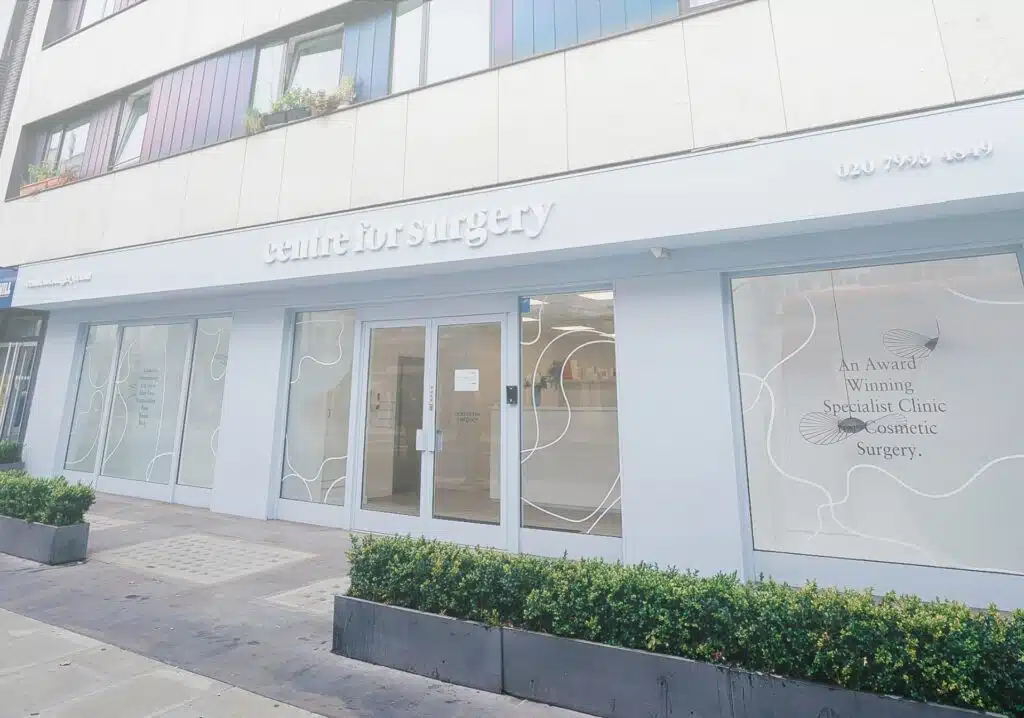Vaginoplasty, also known as vaginal tightening surgery, is a surgical procedure commonly performed in the UK to reconstruct or tighten the vagina. It is usually performed to improve vaginal function or to correct congenital or acquired anomalies. The procedure may involve removing excess skin, tightening the vaginal walls and muscles, and re-establishing the right balance of hormones to enhance sexual function. Centre for Surgery in London is a specialist centre of excellence for cosmetic gynaecology, and our expert gynaecologists regularly perform vaginoplasty and vaginal tightening surgery at our Baker Street clinic in Marylebone.
What is a Vaginoplasty?
A vaginoplasty is a surgical procedure in the field of gynaecology aimed at helping women regain control of their sexual health and improve their vaginal well-being. This surgery is particularly effective in addressing vaginal relaxation syndrome, a condition where the vagina becomes loose and loses its tightness over time.
In essence, vaginoplasty involves either constructing a new vaginal canal or reconstructing an existing one. The surgery focuses on reshaping the vaginal tissues to achieve the patient’s desired appearance and functional outcomes. This process not only restores the vagina’s tightness but also enhances its overall structure and aesthetics, contributing to better sexual satisfaction and improved vaginal health for women.
RELATED: Labiaplasty & Vaginoplasty – What Procedure is Right for You?
What is the function of the vagina?
Where is the perineum and what does it do?
The perineum is an area of the body that might not be talked about often, but it plays a crucial role in both men’s and women’s health. Situated between the anus and the genital area—the vulva in women and the scrotum in men—this region is both muscular and fibrous, providing essential support and function.
One of the perineum’s key roles is to support the pelvic organs. This includes the bladder, the rectum, and, in women, the uterus, helping to maintain their proper position and function. Beyond structural support, the perineum is rich in sexually sensitive nerve endings. This makes it an important player in sexual pleasure, contributing to the overall sexual experience.
During childbirth, the perineum becomes especially significant for women. It stretches to allow a baby to be born, a natural process that can sometimes lead to tearing. To manage this risk and aid in delivery, healthcare providers may perform an episiotomy—a small cut to enlarge the vaginal opening. However, this practice has become less common as research offers new insights into managing childbirth.
The perineum also contains the pelvic floor muscles, vital for controlling the bladder and bowel. These muscles work like a hammock, holding in the pelvic organs and aiding in the functioning of the urinary and digestive systems.
However, the perineum can be prone to damage or injury, particularly from childbirth, certain physical activities, or strain. Damage can lead to issues such as tears, weakened pelvic floor muscles, or pelvic organ prolapse, where the organs drop from their usual position. To address these problems, treatments may include exercises to strengthen the pelvic floor, or surgery, like perineoplasty or pelvic floor reconstruction, to repair damage and restore function.
What are the most common symptoms of a loose vagina?
Vaginal looseness, also known as vaginal relaxation, is a condition in which the vaginal walls become stretched or lax, which can cause a reduction in tone and elasticity. It is a common concern for many women and can result from a variety of causes, including childbirth, ageing, hormonal changes, and lifestyle factors. The most common symptoms of vaginal looseness include:
- Loss of tightness: Women with vaginal looseness may feel a sense of looseness or “empty” feeling in their vagina, which can result in decreased sexual satisfaction for both partners.
- Decreased sexual pleasure: The loss of tone and elasticity in the vaginal walls can lead to decreased sexual sensation and pleasure during sexual activity.
- Incontinence: Vaginal looseness can cause pelvic organ prolapse, resulting in urinary or faecal incontinence.
- Decreased sexual satisfaction: The reduced tightness and sensation in the vagina can lead to decreased sexual satisfaction for both partners.
- Discomfort during physical activity: Women with vaginal looseness may experience discomfort or pain during physical activities such as exercising or horseback riding.
- Increased vaginal infections: The loss of tone in the vaginal walls can cause the vaginal environment to become more alkaline, which can increase the risk of vaginal infections such as yeast infections and bacterial vaginosis.
RELATED: Loose Vagina – Causes and Treatments
In some cases, lifestyle changes, such as maintaining a healthy weight, avoiding smoking, and avoiding irritating products, may also help improve vaginal health and reduce the symptoms of vaginal looseness. The definitive treatment for a loose vagina is vaginal tightening surgery.
SUITABLE CANDIDATES
Am I suitable for vaginal tightening surgery?
Whether you are suitable for vaginal tightening surgery (also known as vaginoplasty) will depend on several factors, including your medical history, overall health, and the specific reasons for your concern about vaginal looseness. It is important to discuss your concerns with a qualified cosmetic gynaecologist, who can evaluate you and determine if you are a good candidate for vaginoplasty.
Some common reasons for seeking vaginal tightening surgery include the following:
- Childbirth: Women who have experienced vaginal childbirth may develop vaginal looseness as a result of the stretching and trauma of delivery.
- Ageing: As women age, hormonal changes and the natural process of ageing can result in a loss of vaginal tone and elasticity.
- Hormonal changes: Hormonal changes, such as menopause, can also affect vaginal health and contribute to vaginal looseness.
- Genetic factors: Some women may have a genetic predisposition to vaginal looseness.
If you are considering vaginal tightening surgery, it is important to be in good general health and to have realistic expectations about the results of the procedure. You should also be willing to follow pre- and postoperative instructions and attend follow-up appointments with your surgeon. Your surgeon will also discuss any potential risks or complications associated with the procedure, as well as the benefits and potential outcomes.
Is it Best to Finish Having Children Before Getting a Vaginoplasty?
A common consideration for women contemplating a vaginoplasty is whether to wait until they have completed their families before undergoing the procedure. Although the surgery does not interfere with your ability to become pregnant or deliver children, it is important to note that childbirth can stretch the vaginal muscles again, potentially diminishing the results of the vaginoplasty.
RELATED: Should You Wait Until You are Done Having Children to Get a Vaginoplasty?
In fact, many women prefer to wait until they are certain they are finished having children before opting for this surgery. This approach helps to avoid the need for a repeat procedure, which might be necessary to restore the desired tightness and appearance if the vaginal muscles are stretched during subsequent pregnancies and childbirths.
Given these factors, it is often advisable to complete your family before undergoing a vaginoplasty. By doing so, you can maintain the results of the surgery without the concern of childbirth reversing the benefits. This is why many women choose to have the procedure only after they are certain they will not have more children.
Is There Another Type of Vaginoplasty Procedure If I Haven’t Finished Having Children?
If you haven’t finished having children or are uncertain about your future plans for more children, you have options other than surgical vaginoplasty. One effective alternative is IntimaLase, a non-surgical laser vaginal tightening procedure. IntimaLase offers similar results to traditional vaginoplasty by enhancing vaginal tightness without the need for surgery.
This procedure uses laser technology to stimulate collagen production and tighten the vaginal tissues. The effects of IntimaLase can be long-lasting and provide significant improvement in vaginal tightness. It’s a suitable option for women who want to improve their vaginal health and sexual satisfaction without undergoing a surgical procedure, allowing them to maintain flexibility regarding future childbirth plans.
How do I know I need a perineoplasty?
A perineoplasty may be recommended if you are experiencing any of the following symptoms or problems related to perineal damage:
- Pain: Chronic or intermittent pain in the pelvic region, particularly during intercourse.
- Incontinence: Urinary or faecal incontinence caused by weakened pelvic floor muscles.
- Sexual dysfunction: Pain or discomfort during intercourse or reduced sexual pleasure caused by perineal damage.
- Pelvic organ prolapse: Dropping of one or more pelvic organs into the vaginal canal due to weakened support.
- Scarring and disfigurement: Scarring and disfigurement of the perineal area that affects self-esteem.
- Discomfort and itching: Skin irritation, itching, and other discomforts in the vaginal and perineal areas.
PROCEDURE
Which type of specialist performs vaginoplasty at Centre for Surgery?
Vaginoplasty is performed by a trained cosmetic gynaecologist. Centre for Surgery is home to specialist female cosmetic gynaecologists who regularly perform vaginal tightening procedures at our state-of-the-art Baker Street clinic in Marylebone.
How is a Vaginoplasty Performed?
On the day of your vaginoplasty, you will arrive at our Baker Street Centre, where the procedure is performed on an outpatient basis. You will be administered the appropriate anaesthesia to ensure you are completely asleep and comfortable during the surgery. The vaginoplasty typically takes about ninety minutes to complete. However, if you are combining it with other procedures, such as a labiaplasty, the overall duration will be longer.
During the procedure, the surgeon will focus on tightening the relaxed muscles within the vagina. These muscles are not only tightened but also reinforced, which enhances pelvic floor control and results in a narrower vaginal diameter. This surgical tightening is designed to restore both the function and the appearance of the vaginal area.
Once the surgery is finished, you will be moved to a recovery area where you will be closely monitored for any signs of complications. If everything is stable and there are no issues, you will be allowed to go home the same day to continue your recovery in the comfort of your own surroundings.
RECOVERY AND AFTERCARE
What is the vaginoplasty recovery like?
Vaginoplasty is a commonly undertaken surgical procedure designed to tighten the vaginal walls and improve vaginal health. The recovery period after vaginoplasty can vary depending on several factors, including the extent of the procedure, the patient’s overall health, and the patient’s ability to follow the postoperative instructions provided by the surgeon.
RELATED: What is recovery like after vaginoplasty surgery?
In general, the following can be expected during the recovery period after vaginoplasty:
- Pain and discomfort: Patients can expect some discomfort and pain during the recovery period, which can be managed with over-the-counter pain medications and/or prescription pain medications as prescribed by the surgeon.
- Swelling: Patients can expect some swelling in the vaginal area during the recovery period, which should subside within a few days to a week.
- Activity restrictions: Patients should avoid strenuous activity and sexual intercourse for several weeks after the procedure to allow the vaginal tissues to heal properly.
- Follow-up appointments: Patients should attend all follow-up appointments with the surgeon to monitor their progress and to ensure that the healing process is progressing as expected.
- Gradual return to normal activities: Patients can expect to gradually return to normal activities over the course of several weeks, although a full recovery can take several months.
RELATED: What Does it Feel Like After Vaginoplasty?
Is vaginoplasty painful?
Vaginoplasty is a surgical procedure that is performed under general or local anaesthesia, and the level of pain experienced during and after the procedure will depend on a variety of factors, including the type of anaesthesia used, the extent of the procedure, and the patient’s individual pain tolerance.
RELATED: Is Vaginoplasty Painful?
Most patients report some level of discomfort or pain during the recovery period after vaginoplasty, which can typically be managed with over-the-counter pain medications and/or prescription pain medications as prescribed by the surgeon. The discomfort or pain should subside over time as the vaginal tissues heal.
Is vaginoplasty safe?
Vaginoplasty, like any surgical procedure, carries certain risks and potential complications. However, when performed by a qualified and experienced cosmetic gynaecologist, vaginoplasty is generally considered safe.
RELATED: Vaginoplasty Safety Guidelines: What You Need to Know
Is vaginoplasty permanent?
The results of vaginoplasty are generally considered to be long-lasting but not permanent. The effects of ageing, pregnancy, childbirth and other factors can affect the results over time and may result in a gradual loosening of the vaginal tissue. Additional touch-up procedures may sometimes be necessary to maintain the desired results.
RISKS AND COMPLICATIONS
Are There Risks to a Vaginoplasty?
Like all surgical procedures, vaginoplasty does come with certain risks, although the likelihood of complications is generally quite low. It is important to be aware of potential issues that may arise during the recovery period. Some risks to watch out for include persistent redness, bruising, and severe pain that does not diminish over time. Additionally, heavy bleeding and signs of infection are concerns. Symptoms of infection can include nausea, vomiting, fever, intense pain, itching, and a burning sensation.
Despite these potential risks, vaginoplasty is considered a relatively safe procedure with minimal drawbacks. It is a popular choice among women aged thirty to fifty who have completed their families. Additionally, many women who have gone through menopause opt for this procedure to regain their confidence and enhance their sexual lives. While being mindful of the risks, many find the benefits of improved vaginal tightness and function to be well worth the potential complications.
Can I get vaginoplasty surgery on the NHS?
In the UK, vaginoplasty is considered to be an elective or cosmetic procedure, and as such, it is not typically covered by the National Health Service (NHS). Patients who want to undergo vaginoplasty will typically need to pay for the procedure privately.
However, there are some circumstances in which vaginoplasty may be covered by the NHS. For example, if a patient is experiencing functional problems or discomfort resulting from vaginal looseness that is causing significant distress, they may be eligible for vaginoplasty under the NHS.
Vaginoplasty Surgery at Centre for Surgery
Many women are affected by vaginal looseness, which is linked to several medical conditions, including stress urinary incontinence and pelvic organ prolapse. Vaginoplasty surgery is a highly effective surgical treatment to relieve many common symptoms experienced by women after pregnancy. Get in touch with us today at 0207 993 4849 or complete the contact form below to schedule an in-person consultation with a specialist surgeon at our Baker Street clinic in Marylebone.











